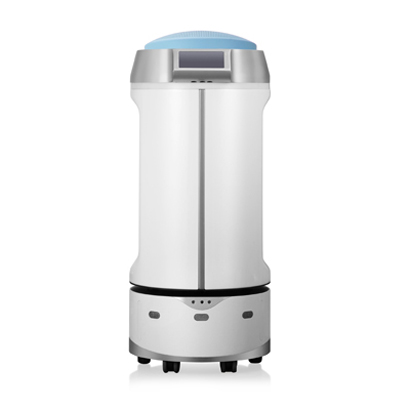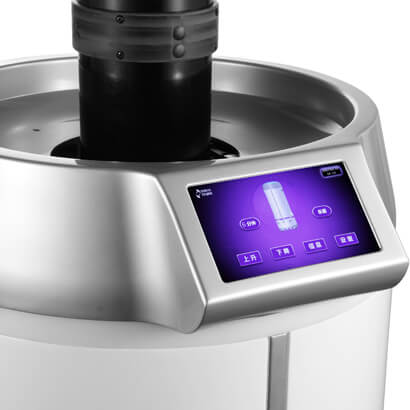Prominent Features of Pulsed UV Germ-Killing Robots
2022-03-30 by hqt

Many facilities have UV-C disinfection equipment, but they continue to have old complaints related to low efficiency and the occurrence of easily treatable pathogens. Usually these problems occur due to a bad selection of Pulsed UV Germ-killing Robots.
The vast majority of equipment available does not describe the capacity of their equipment by dose, which should be mandatory. Only our pulsed germ killing robots guarantee maximum disinfection in less than five minutes.
Optimize the use of the UV-C disinfection system
The combined use of a good mechanical filter for the removal of solids and organic matter will leave the water with greater transmittance and a lower bacterial load, optimizing the use of the Pulsed UV Germ-killing Robots.
DONEAX has an exclusive line of UV-C disinfection for wide range of industries. In simple terms every place that has run of crowd on massive level every day, it needs these robot. This is to ensure comprehensive protection of your customers.
One of the most amazing features of this robot is its automation. There is no manual labor input. Furthermore, its effectiveness is quite reliable too. It can be easily sized to meet different flow rates in different dose requirements.
Pulsed UV Germ-killing Robots helps to protect against viruses
Doneax wide range of surface disinfection robots will help protect against viruses during the season of increased risk of the spread of infectious diseases. Pulsed UV Germ-killing Robots are available for purchase.
Pulsed UV Germ-killing Robots effectively fights harmful microorganisms
UV germ killing robots effectively fights harmful microorganisms and viruses in the air and on accessible surfaces. It provides reliable disinfection of a room with an area of 3 meters.
UV robots effectively destroy 99% of pathogenic microbes and viruses in the air and on surfaces. Treatment with a UV robot allows you to kill germs in hospitals and operation rooms. It also kills coronavirus, enterovirus EV71. Due to its oxidizing properties, ozone eliminates unpleasant odors. After processing, the room is subject to mandatory ventilation.
A Comprehensive Solution to Disinfect Environment
It is no secret that uv robots can effectively sterilize and disinfect the environment from viruses and pathogens.
- This applies equally to both air and surface.
- True, not all ultraviolet does this, but only rays with a certain wavelength.
How to choose Pulsed UV Germ-killing Robots?
It all depends on what type of ultraviolet light the bulb emits.
Types of UV
Ultraviolet is divided into three types:
UV-A – long wavelength UV (soft)
It has a wavelength from 315nm to 400nm. This is used in banknote detectors, lamps for manicure or in discos.
UV-B – medium wave
It has a length of 280nm-315nm. From such rays we get a natural sun or artificial tan in special spas.
UV tan
Both UV-A and UB-B are present in different proportions in the natural environment thanks to our sun.
UV-C – shortwave UV (hard)
And this is exactly what we need. Here the wavelengths are 100-280nm. They are harmful to bacteria.
What is the function of Pulsed UV Germ-killing Robots?
In the natural environment, such ultraviolet radiation is almost completely absorbed by the ozone layer of the earth and does not reach us. Therefore, it is produced artificially using light bulbs containing mercury or assembled on special UV-C LEDs.

Pulsed UV Germ-killing Robots: local processing at home
Pulsed UV Germ-killing Robots are suitable for use in all areas of the house to disinfect the air and surfaces of furniture, carpets, textiles and outerwear.
The Pulsed UV Germ-killing Robots uses in offices, restaurants and cafes, fitness rooms. It protects the health of employees and customers on a daily basis. You can add processing cycles to the schedule during non-working hours or at night when no one is in the premises.
The germ killing robots are also good for preventive disinfection of inventory after routine cleaning in medical centers and beauty salons.
The portable Pulsed UV Germ-killing Robots are more mobile and can be taken with you to disinfect surfaces. It can be used in limited to open spaces, in the fitness center, in hotel rooms while traveling, in photo studios and dressing rooms, in co-working spaces.
Disinfection of personal cars and taxis
Ultraviolet radiation has long been successfully used in medicine, for disinfection of operating rooms, wards and other premises of infectious diseases departments, in laboratories and in the production of medications. Quartz and ozone-free Pulsed UV Germ-killing Robots and irradiators have proven effective in inactivating bacteria, viruses and fungi harmful to human health.
Choosing the right uv robot
So what kind of uv robot can and should be used? For example, such as Pulsed Xenon UV Germ-killing Robots Pulsein-D.
Use of an ultraviolet lamp in everyday life
An ultraviolet lamp or UV lamp, adapted for use in everyday life. It has become relevant again recently – during the pandemic of the COVID-19 virus. It also useful during periods of seasonal epidemics of infectious viral diseases. Such a lamp will help the rest of the family stay healthy even if one of them gets sick.
Use of UV Rays in Various Sectors
For disinfection of surfaces to protect medical facilities from pathogenic bacteria, ultraviolet is used in commercial industry enterprises. Ultraviolet radiation is electromagnetic radiation that occupies the spectral range between X-rays and visible radiation. It is the fact that ultraviolet light extends the protection. Among all disinfectants such as chlorine or ozone, UV radiation is the most effective disinfectant.
We offer equipment that can be used in a variety of areas. This:
- Disinfection of surfaces and premises;
- Disinfection of indoor air;
- Medical disinfection;
- Warehouses for food and refrigeration units;
- Disinfection of commercial spaces.
Currently, bactericidal irradiator Pulsed UV Germ-killing Robots are especially popular and in high demand for use in apartments and private homes, educational institutions, libraries, offices, medical facilities, industrial workshops, shopping or sports centers.

